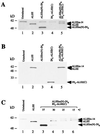Protein trans-splicing to produce herbicide-resistant acetolactate synthase
- PMID: 11229887
- PMCID: PMC92690
- DOI: 10.1128/AEM.67.3.1025-1029.2001
Protein trans-splicing to produce herbicide-resistant acetolactate synthase
Abstract
Protein splicing in trans has been demonstrated both in vivo and in vitro by biochemical and immunological analyses, but in vivo production of a functional protein by trans-splicing has not been reported previously. In this study, we used the DnaE intein from Synechocystis sp. strain PCC6803, which presumably reconstitutes functional DnaE protein by trans-splicing in vivo, to produce functional herbicide-resistant acetolactate synthase II (ALSII) from two unlinked gene fragments in Escherichia coli. The gene for herbicide-resistant ALSII was fused in frame to DnaE intein segments capable of promoting protein splicing in trans and was expressed from two compatible plasmids as two unlinked fragments. Cotransformation of E. coli with the two plasmids led to production of a functional enzyme that conferred herbicide resistance to the host E. coli cells. These results demonstrate the feasibility of expressing functional genes from two unlinked DNA loci and provide a model for the design of nontransferable transgenes in plants.
Figures





Similar articles
-
Herbicide resistance from a divided EPSPS protein: the split Synechocystis DnaE intein as an in vivo affinity domain.Gene. 2001 Jan 24;263(1-2):39-48. doi: 10.1016/s0378-1119(00)00568-0. Gene. 2001. PMID: 11223241
-
Zinc inhibition of protein trans-splicing and identification of regions essential for splicing and association of a split intein*.J Biol Chem. 2001 Jun 29;276(26):24051-8. doi: 10.1074/jbc.M011049200. Epub 2001 Apr 30. J Biol Chem. 2001. PMID: 11331276
-
Zinc ion effects on individual Ssp DnaE intein splicing steps: regulating pathway progression.Biochemistry. 2003 May 13;42(18):5301-11. doi: 10.1021/bi020679e. Biochemistry. 2003. PMID: 12731871
-
Biosynthesis of 2-aceto-2-hydroxy acids: acetolactate synthases and acetohydroxyacid synthases.Biochim Biophys Acta. 1998 Jun 29;1385(2):401-19. doi: 10.1016/s0167-4838(98)00083-1. Biochim Biophys Acta. 1998. PMID: 9655946 Review.
-
Growth inhibition as a consequence of antagonism between related amino acids: effect of valine in Escherichia coli K-12.Microbiol Rev. 1979 Mar;43(1):42-58. doi: 10.1128/mr.43.1.42-58.1979. Microbiol Rev. 1979. PMID: 379577 Free PMC article. Review. No abstract available.
Cited by
-
Intein-mediated assembly of a functional beta-glucuronidase in transgenic plants.Proc Natl Acad Sci U S A. 2003 Mar 18;100(6):3513-8. doi: 10.1073/pnas.0635899100. Epub 2003 Mar 10. Proc Natl Acad Sci U S A. 2003. PMID: 12629210 Free PMC article.
-
Reconstitution of glyphosate resistance from a split 5-enolpyruvyl shikimate-3-phosphate synthase gene in Escherichia coli and transgenic tobacco.Appl Environ Microbiol. 2007 Dec;73(24):7997-8000. doi: 10.1128/AEM.00956-07. Epub 2007 Oct 19. Appl Environ Microbiol. 2007. PMID: 17951442 Free PMC article.
-
Protein trans-splicing of multiple atypical split inteins engineered from natural inteins.PLoS One. 2013 Apr 8;8(4):e59516. doi: 10.1371/journal.pone.0059516. Print 2013. PLoS One. 2013. PMID: 23593141 Free PMC article.
-
Protein trans-splicing in transgenic plant chloroplast: reconstruction of herbicide resistance from split genes.Proc Natl Acad Sci U S A. 2003 Apr 15;100(8):4510-5. doi: 10.1073/pnas.0736538100. Epub 2003 Apr 1. Proc Natl Acad Sci U S A. 2003. PMID: 12671070 Free PMC article.
-
Functional analysis of the split Synechocystis DnaE intein in plant tissues by biolistic particle bombardment.Transgenic Res. 2006 Oct;15(5):583-93. doi: 10.1007/s11248-006-9004-8. Epub 2006 Jul 9. Transgenic Res. 2006. PMID: 16830226
References
-
- Behncken S N, Billestrup N, Brown R, Amstrup J, Conway-Campbell B, Waters M J. Growth hormone (GH)-independent dimerization of GH receptor by a leucine zipper results in constitutive activation. J Biol Chem. 2000;275:17000–17007. - PubMed
-
- Bernasconi P, Woodworth A R, Rosen B A, Subramanian M V, Siehl D L. A naturally occurring point mutation confers broad range tolerance to herbicides that target acetolactate synthase. J Biol Chem. 1995;270:17381. - PubMed
-
- Evans T C, Jr, Martin D, Kolly R, Panne D, Sun L, Ghosh I, Chen L, Benner J, Liu X Q, Xu M-Q. Protein trans-splicing and cyclization by a naturally split intein from the dnaE gene of Synechocystis species PCC6803. J Biol Chem. 2000;275:9091–9094. - PubMed
-
- Ferber D. Ecology. New corn plant draws fire from GM food opponents. Science. 2000;287:1390. - PubMed
MeSH terms
Substances
LinkOut - more resources
Full Text Sources
Other Literature Sources

